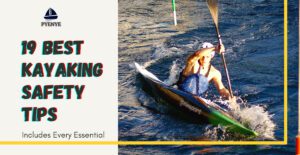Using a tandem kayak for solo paddling may sound weird, but you can actually do this. It requires some additional setup, as well as an understanding of the different paddling techniques and experience to handle the uncertain situation on the water. But with proper techniques and safety precautions, you can enjoy kayaking alone in a tandem kayak, just like any other vessel.
In short, yes. You can surely use a tandem kayak as a single user! However, it might not be as comfortable or efficient as using two people. But you can perform it! Just make sure that you choose one that fits your size and skill level appropriately and offers features suited for solo paddling.
A Tandem or a double kayak is designed to carry two people, but that doesn’t mean you can’t enjoy the same experience by yourself. With a few simple modifications and adjustments, you can make your tandem kayak suitable for solo paddling.
Here’s how you can simply do this:
Jump To A Section
How To Use A Tandem Kayak For Solo Paddling
Tandem kayaks are great for paddling with a partner, but they can also be used by one experienced paddler. With a few simple modifications and some practice, you can use a tandem kayak to paddle solo in comfort and safety.
Move To The Center
The key to successfully paddling a tandem kayak alone is sitting in the middle of the boat. This gives you access to both sides of the craft, allowing better control over your direction and speed. You may need to adjust your seating position slightly so that you’re comfortable and able to paddle effectively.
Use Lightweight Equipment
Selecting lightweight accessories such as paddles or life vests will make solo paddling easier by reducing fatigue and increasing efficiency. Also, consider bringing along fewer items than usual when paddling alone, as additional weight in the back can affect steering and speed.
Balance Your Weight
When sitting in the center of your tandem kayak, try to maintain an even balance of weight on each side of the craft while using proper technique when executing strokes with either paddle blade. Doing so will help reduce strain on your body while also providing better control when navigating through difficult waters or strong currents.
Utilize A Rudder Or Skeg
Adding either a rudder or skeg will assist with tracking (the ability of a craft to hold its course). They are especially useful when dealing with changing wind directions or waves that could potentially push your craft off course during long trips into open waters.
For those who are new to this type of activity, adding either one of these items may help increase confidence during longer trips alone in a tandem kayak.
Practice Before Leaving Shore
Solo paddling requires advanced skills. So, you must practice it well before heading out into open waters on your own.
Take some time practicing basic strokes. Especially the forward and reverse sweeps, J-strokes, draw strokes, etc., before embarking on longer journeys. This will give you greater control over your vessel while increasing overall safety during every trip out onto the water!
Advantages and Disadvantages of Using a Tandem kayak For Solo Paddling
The first advantage that comes with using a tandem kayak for solo paddling maybe it increases stability. Since two people are sitting side by side in the same boat, each person’s weight helps create more balance and stability in the water. This makes it easier to stay upright when negotiating choppy waters or navigating through rapids.
The main disadvantage of using a tandem kayak for solo paddling is that it limits your range of motion while navigating through narrow passages or tight turns. With both paddle blades attached to the same shaft, it can be difficult to apply maximum power when turning or changing direction during your journey.
Additionally, some tandem kayaks are not designed with one-person operation in mind. This means they may lack features such as adjustable footrests and longer seat backs. And this would make them difficult for single-person use.
Another downside of using a tandem kayak for solo paddling is its size and weight relative to other vessels. Since they hold two people, they tend to be larger and heavier than many other boats on the water.
This makes them less suitable for those who want an easily transportable craft or those looking to paddle quickly over long distances at speed.
Tips for Safely Using a Tandem Kayak as a Single User
One of the biggest challenges of kayaking is safely using a tandem kayak as a single user. This can be tricky because the kayak is designed for two people, and it may not be stable enough for one person.
Here are some tips for safely using a tandem kayak as a single user:
Adjust Foot Pegs to Accommodate One Person’s Size and Weight Load
Foot pegs are used to secure the paddler’s feet in the kayak’s cockpit. Here you should also adjust the foot pegs to accommodate the size and balance the weight load. This will help ensure the kayak is stable and balanced, reducing the risk of tipping over.
Select the Appropriate Paddles for Single-User Use
Most tandem kayaks come with two paddles. But when using a tandem kayak as a single user, you should select a single paddle that is the right size and weight for the paddler. Look for paddles that are light yet strong, and have a comfortable grip. This will help to ensure you have the right amount of power and control when paddling.
Consider Adding Additional Flotation Devices or Outriggers for Added Stability and Balance
When using a tandem kayak as a single user, consider adding additional flotation devices such as outriggers or floatation bags. These devices will help to provide extra stability and balance. This makes it easier to maneuver the kayak. And it also reduces the risk of tipping over.
Overall, there are certainly some disadvantages associated with using a tandem kayak for solo paddling. Balancing issues and limited range of motion when negotiating tight spaces are crucial of them. And you can minimize these difficulties by adapting your paddling techniques accordingly.


